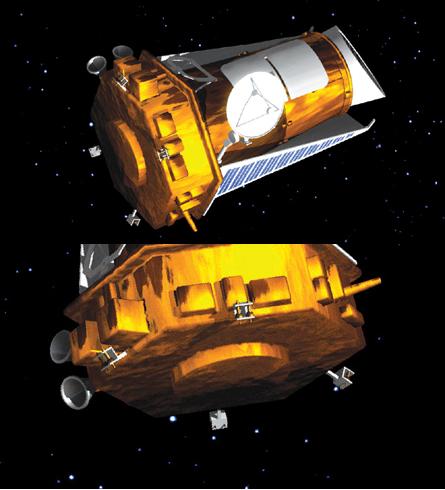In the third article in the series, we will focus on the Kepler telescope that will search for life in distant stars, and we will present telescopes that have examined the time deviation in the sky and the expansion of the universe

Kepler - waiting for signals from a distant world
Sponsor: NASA
Location: Earth's path around the Sun
Cost: $ 467,000,000
Estimated completion: 2007
Have you ever wondered if there is extraterrestrial life? It would be nice if a neighboring alien would wave his hand and say "Hey! I'm here!". The problem is, we're not even close to building a telescope that can spot an alien waving its hand. We can't even build a telescope that can see a planet around a star. The most we can do is infer that planets exist by detecting their gravitational pull on the parent star, and this technique, called radial velocity, is limited to gas giants at least the size of Neptune. So far we have discovered 150 strange gas balls. We cannot yet see anything that resembles Earth. Nothing is solid enough to allow our kind of alien to exist. But maybe we can see his signal.
Imagine our friendly alien sitting on a planet orbiting its parent star "on edge": from our perspective, the planet hides behind the star and then crosses, or passes, the face of the star as it orbits. When the planet passes in front of the star, it will block a tiny part of that star's light. The star will appear as if it is dimmer - that is, as if it is signaling. If we can see this dimming, we won't know if our alien is actually there, but we will know that there is a solid rock there for him to sit on.

Kepler - antenna and solar array
That's what's driving the Kepler mission, which is scheduled for launch in October 2007. Kepler is the brainchild of a space scientist at the NASA Research Center who began testing the potential for detecting moving planets in 1984. Early on, he realized how difficult it would be to detect planets. Pleasant in the size of the earth. If every star in the sky has an Earth-sized planet moving around it, then from our perspective only one in 200 will move across the planet. Moreover, rocky planets are so small that detectors are required that are able to distinguish a tiny dimming within the brightness of a star - one in a hundred thousand. The task is similar to discovering a grain of sand flying past a distant bulb.
To overcome the one-in-200 planet problem, Kepler would have to examine many stars. The telescope, 0.95 meters wide, will point in the direction of one of the arms of the Milky Way and capture an enormous visual field: over 100 square degrees of sky, 20 lunar diameters in each direction. and then he will wait. Unlike most telescopes, which scan the sky to discover different types of objects of interest, Kepler will fix its gaze on those 100,000 sun-like stars without moving. Kepler will be a giant camera of the sky. If one of those stars dims even a little, we will see it. Rocky planets are small and gas planets are large. Kepler will be able to calculate the size of the planet with an accuracy of 7 percent, so it will be able to determine which of the planets that will be discovered are rocky. In addition, it will measure the orbits to check which of the planets are suitable for habitation in terms of temperatures that allow the existence of water and therefore also friendly aliens.
The most important thing: Kepler will observe a huge sample of stars. This is the first exoplanetary search that focuses on one place. It will generate statistics. As a result, the conclusions he draws will tell us much more than whether Earth-like planets exist. It will tell us how common or rare such planets are. If a large number of Earths are discovered, then there is a lot of life in space.
kepler.arc.nasa.gov
The Large Synoptic Survey Telescope
The time warp films in the sky
LSST is designed to transform cosmic cartography into celestial cinematography. It will make time warp movies in the visible cosmos to see what has changed there. It will detect, track, and test all near-Earth-threatening asteroids that exceed 130 meters in width. Particularly exciting is the possibility to investigate a number of objects flashing in blue light that were recently discovered and whose origin is unknown.
Estimated completion: 2013
lsst.org
Supernova Acceleration Probe
The black energy cannot hide
In 1998, cosmologists announced that an unknown force was expanding the universe. But not only do we not know what this "black energy" is, we don't even know if it is a constant or variable force. To answer this question, cosmologists need better history data of the cosmic expansion. For this purpose, the SNAP satellite will be introduced, which will measure thousands of white dwarfs - remnants of supernova explosions - to monitor the expansion of the universe over time.
Estimated completion: 2015
snap.lbl.gov
Astrophysics connoisseur - the universe
https://www.hayadan.org.il/BuildaGate4/general2/data_card.php?Cat=~~~200534213~~~249&SiteName=hayadan
